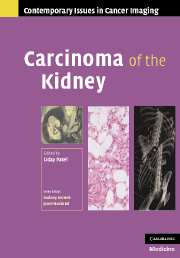Book contents
- Frontmatter
- Contents
- Contributors
- Series foreword
- Preface to Carcinoma of the Kidney
- 1 Renal cell cancer: overview and immunochemotherapy
- 2 Pathology of adult renal parenchymal cancers
- 3 Familial and inherited renal cancers
- 4 Radiological diagnosis of renal cancer
- 5 Staging of renal cancer
- 6 The case for biopsy in the modern management of renal cancer
- 7 Imaging characteristics of unusual renal cancers
- 8 Surgery for renal cancer: current status
- 9 Ablation of renal cancer
- 10 Post-treatment surveillance of renal cancer
- 11 Imaging for nephron-sparing procedures
- Index
- Plate Section
- References
2 - Pathology of adult renal parenchymal cancers
Published online by Cambridge University Press: 08 August 2009
- Frontmatter
- Contents
- Contributors
- Series foreword
- Preface to Carcinoma of the Kidney
- 1 Renal cell cancer: overview and immunochemotherapy
- 2 Pathology of adult renal parenchymal cancers
- 3 Familial and inherited renal cancers
- 4 Radiological diagnosis of renal cancer
- 5 Staging of renal cancer
- 6 The case for biopsy in the modern management of renal cancer
- 7 Imaging characteristics of unusual renal cancers
- 8 Surgery for renal cancer: current status
- 9 Ablation of renal cancer
- 10 Post-treatment surveillance of renal cancer
- 11 Imaging for nephron-sparing procedures
- Index
- Plate Section
- References
Summary
Introduction
There have been a number of recent advances in our understanding of the pathology of renal cancer. This has not only resulted in some re-classification of cancer types but also improved our ability to pathologically characterize tumors allowing improved prognostication. All these aspects are reviewed here. Additionally the role of modern immunohistochemistry in the characterization of tumors from samples obtained by image-guided core biopsy is discussed.
Pathological classification of malignant renal tumors
Previous classifications
Previous classifications of renal tumors were based on their morphology, resulting in numerous subtypes and practical difficulties because of overlapping appearances. Subsequently, greater understanding of the genetic alterations underlying different subtypes and their morphological correlates led to a simplified and more relevant classification – the Heidelberg consensus classification. Whereas the original World Health Organization (WHO) classification separated clear cell from granular cell renal carcinomas, cytogenetic analyses revealed that these were different manifestations of the same abnormality involving the von Hippel–Lindau (VHL) gene on the short arm of chromosome 3, giving rise to the most common type of renal carcinoma. These “conventional” carcinomas have variable proportions of clear or granular cells (Figure 2.1) depending on the cytoplasmic content of fat (which “clears” during histological processing) or mitochondria (responsible for the granular or oncocytic appearance of cells). Spindle cell or sarcomatoid change has long been recognized as an indication of poor differentiation rather than an indication of cell lineage, and tumors within the WHO spindle cell category could often be classified by cytogenetic analysis.
- Type
- Chapter
- Information
- Carcinoma of the Kidney , pp. 17 - 37Publisher: Cambridge University PressPrint publication year: 2007



